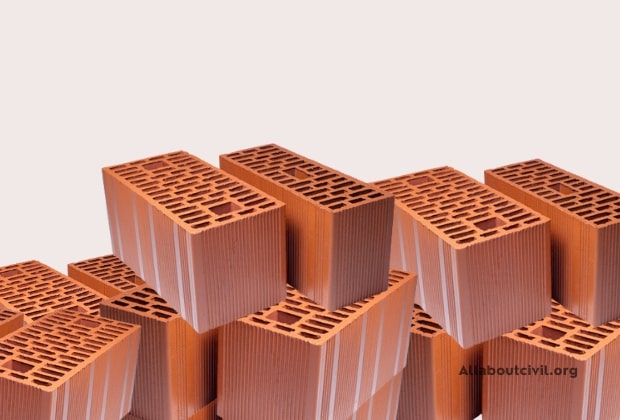As we know bricks are one of the primary building materials in construction and have excellent properties and advantages. With modern innovation in the construction sector, many forms of bricks are formed based on the requirements in terms of design, durability, and cost-effectiveness.
In this article, we will discuss hollow blocks disadvantages and advantages, sizes, and making process.
What are Hollow Bricks?
Hollow bricks, also known as hollow concrete blocks, are building materials used in construction. They are made of concrete or other cementitious materials and are characterized by their unique shape, with hollow cavities or voids (which are 25%-60% of their bed area )in the middle of the brick.

Hollow bricks are famous in construction because they are lightweight and easy to handle, which makes them ideal for use in both load-bearing and non-load-bearing walls. They are also known for their thermal insulation properties, which can help to reduce energy consumption in buildings.
In addition to their practical benefits, hollow bricks are also known for their aesthetic appeal. They come in a variety of shapes and sizes and can be used to create interesting patterns and designs on the walls of a building, which we discussed in detail below.
Advantages of Hollow Bricks
Hollow bricks have a lot of advantages over traditional solid bricks in construction which are discussed below.
1. Lighter in weight
Hollow bricks are lighter in weight than solid bricks due to their hollow space in the middle, making them easier to handle, transport, and install. It reduces the dead load of the structure.
2. Better insulation
The voids of the hollow bricks provide better insulation, which can help to reduce heating and cooling costs in buildings.
3. Increased strength
Hollow bricks have greater strength and durability than solid bricks because of their unique design. They have high compressive strength (3.5N/mm2)and the hollow spaces make the bricks more resistant to cracking and damage caused by thermal expansion and contraction.
4. Better sound insulation
The hollow core of the bricks provides better sound insulation, making them ideal for use in walls that require soundproofing.
5. Cost-effective
Hollow bricks are more cost-effective than solid bricks because they require less material to manufacture and are lighter to transport.
6. Eco-friendly
Hollow bricks are made from concrete, which is a sustainable and eco-friendly material. They are also recyclable and can be used in a variety of applications.
Overall, the use of hollow bricks can provide a range of benefits, including improved strength, insulation, and cost-effectiveness.
Also Read – Brickwork Calculation Formula
Disadvantages of Hollow Bricks
While hollow bricks have many advantages, there are some disadvantages that should be considered while using them in construction. Here are some of the main disadvantages of hollow bricks:
1. Lower strength
When compared to solid bricks, hollow bricks have a low load-bearing capacity, which means they may not be suitable for certain types of load-bearing walls or structures. And these are not suitable for earthquake-prone areas.
2. Higher water absorption
The hollow cavities inside the bricks can increase the potential for water infiltration, which can lead to moisture problems and structural issues if not properly addressed.
3. Difficult to repair
If a hollow brick is damaged, it can be difficult to repair or replace it without affecting the stability of the wall.
4. Fire resistance
Hollow bricks may not be as fire-resistant as solid bricks or other building materials, which can be a concern in areas with high fire risk.
5. Cost
While hollow bricks can be a cost-effective building material, they may be more expensive than other options in certain regions or depending on the specific requirements of a construction project.
Properties of Hollow Bricks
Here are some of the main properties of hollow bricks:
1. Size and Shape
Hollow clay bricks come in a variety of sizes and shapes, such as standard, rectangular, and square. They can also be customized to fit specific building requirements. Some common sizes are as follows:
- 400 X 200 X 100 ( in mm)
- 400 X 200 X 150 ( in mm)
- 400 X 200 X 200 ( in mm)
- 400 X 200 X 300 ( in mm)
2. Strength and Durability
Hollow bricks are known for their high strength and durability. They can withstand heavy loads, harsh weather conditions, and environmental factors.
3. Thermal Conductivity
Hollow clay bricks have a thermal conductivity of 0.28-0.31W/wk.
4. Dry Density
The dry density of hollow bricks is 694-788Kg/m3.
Also Read –
1. Interview Questions for Civil engineer on Brickwork
FAQs on Hollow Brick Blocks
Ans – Clay hollow bricks are similar to hollow bricks but the material used in making these bricks are clay and natural additives such as sawdust, coal ash, and fly ash.
Ans – Following are the disadvantages of clay hollow bricks.
1. Clay hollow bricks have poor seismic properties.
2. Not suitable foundation or slab due to low resistance against the pressure.
3. Low durability and strength due to high water absorption.
4. Clay hollow bricks are not suitable for load-bearing walls.
Ans- Hollow bricks have a lot of advantages over traditional bricks such as being lighter in weight, cost-effective, less maitance, and comes with great workability, flexibility, and durability, thus making them the best choice for modern structures.

